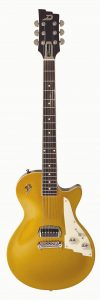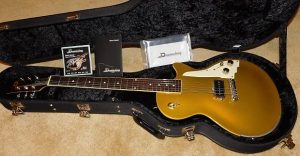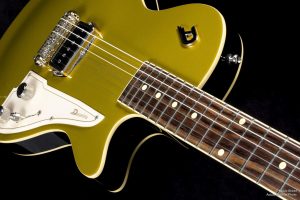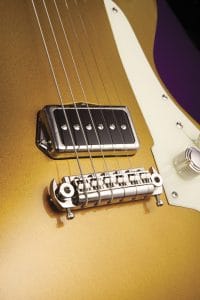Duesenberg 52 Senior Features
Table of Contents
Elevating the single-pickup Junior concept to fully carved-top status and adding clever switching for extra adaptability it’s a stroke of rock genius. One look will be enough to tell you why we featured the Duesenberg 52 Senior in our NAMM 2010 report.
Co-opting the brand name of one of America’s most iconic automobile companies was a shrewd statement of intent, and after taking this fast track to retro chic Duesenberg has borrowed from the likes of Gretsch, Zemaitis, Rickenbacker and D’Angelico to achieve a genuine style all its own.
An impressive artist endorsement list includes assorted Eagles, Stones, Heartbreakers and Bob Dylan, but none of them can claim the same degree of guitar gravitas as Billy F Gibbons, who has already been photographed with this month’s review item.
It makes perfect sense, because if ever a guitar could be described as a six-string hotrod, it’s the 52 Senior. It’s exactly the kind of guitar the Rev might have dreamt up.

It’s not just a cropped Lester goldtop: there are some distinctive constructional and ergonomic twists. The body is sleeker than an LP’s, an effect enhanced by the single bridge pickup and a one-piece bridge/tailpiece.
The shape is closer to a single-cutaway Gretsch Duo Jet, and this similarity goes beyond skin deep, for Duesenberg describes the 52 Senior as a hollowbody – though in reality the weight and balance suggest chambered rather rather than truly hollow construction.
Familiar ingredients include a mahogany back with an arched maple top. This is where the 52 Senior most closely resembles a Les Paul, and the heavily-dished carve suggests that Duesenberg has put much effort into replicating that ’50s look.
It looks glorious with light bouncing off the near-flawless green-tinged metallic gold finish, but the downside is that the flush-to-the-body scratchplate isn’t quite as flush as it might be.
Four screws aren’t quite enough to persuade the plate to conform to the curves, but the small gaps are only noticeable from a player’s point of view. From the front it looks fantastic – and unlike a Lester’s jazz-style pickguard, it won’t get in anybody’s way.
Design
The body binding looks wafer-thin, so Duesenberg probably haven’t scraped the gold back to the full depth. It’s a smart move because there’s enough to define the edge without detracting from that field of gold. The back of the body is bound too, which makes the body appear thinner than it is.
Even so, for the most part the edges measure 424mm, about 5mm slimmer than a Les Paul. Also, with a Fender-style 25.5″ scale, coupled with a custom .010″-.050″ string set, the 52 Senior doesn’t feel much like an LP.
Combining a wrapover tailpiece with a single pickup will interest Junior fans. Big bonus: this bridge allows for individual string adjustment.
Don’t worry about the 52 Senior being a one-trick pony, because the three-way switch plus some trick wiring extracts every ounce of tonal variety from the P90 pickup (customers can also specify a Duesenberg Little Toaster humbucker with the same wiring).

The specs indicate that these voicings are achieved by tapping two individual windings on the bobbin, and there are a couple of caps on the selector switch to further tailor the frequency response. There’s also a master volume and tone.
The bound fingerboard is rosewood, as is the headstock overlay. Stopping the black lacquer 3mm shy from the front of the headstock has created faux binding, neatly exposing a band of the maple used for the set neck.
Ridged kidney buttons on the diecast locking tuners match the stepped headstock shape as well as the metal truss rod cover. Switch tip, knobs, jack plate and ‘D’ motifs on the body and headstock. Standard 52 Seniors feature a nickel-plated arm rest on the upper bout, but you can order them without, like ours.
There’s a Plek machine in the Duesenberg factory, so every guitar gets a computer-controlled fretjob. The dress on the 52 Senior’s jumbo frets is as good as it gets. And there’s no fret buzz or string rattle whatsoever.
Duesenberg 52 Senior Sounds
The absence of f-holes means the 52 Senior’s semi-acoustic qualities are subtle rather than overt. But there’s an extra degree of volume and resonance to enhance the superb clarity and sustain.
The switching genuinely provides three distinct sounds, but P90s do benefit from having their coils closer to the strings. We found the factory setting too low, but the height is easy to adjust.

The bridge position is raunchy, snarling and chimey, delivering a full-frequency P90 assault that can’t be faulted. Switching to the middle results in a treble roll-off and drop in volume -not exactly twangy but certainly an effective. Woody-textured tone for rhythm duties and Travis picking.
The ‘neck’ setting appears to restore all the pickup windings. So output levels equate with the bridge setting, but there’s a preset treble roll-off.
You might think that the tone control renders this setting superfluous. But any Gretsch players who have put useable (ie 0.012mF and 0.0039mF) cap values in their ‘mud’ switches will tell you a preset treble roll-off is a very useable feature. Besides this, the 52 Senior’s preset neck cutoff frequency slightly differs from the tone control cutoff frequency, giving a throatier and smoother tone.
The clean tones are sweet but the 52 Senior really loves overdrive and fuzz. The P90 cuts through with precision, and pinched harmonics abound.
It’s very much a rock, blues and garage band sound rather than something you might use for jazzy or fusion outings. But hey, the looks alone are enough to tell you that.
Best of all, a treble roll-off cap retains the sparkle when you turn down the volume. And the tone control frequency is spot on. I’ve played three-pickup guitars with less versatility.

Verdict
We love the 52 Senior’s design. Some extra attention to detail might have improved the fit and finish around the nut. And we guess that not everyone will care for the feel of the glossy poly finish on the neck. But all in all Duesenberg has successfully lashed together the best bits from a mid-’50s goldtop. A Gretsch Duo Jet, a Les Paul Junior and a Fender Esquire to create something quite distinctive – and utterly desirable.

Leave a Reply
You must be logged in to post a comment.